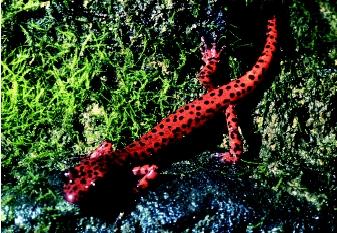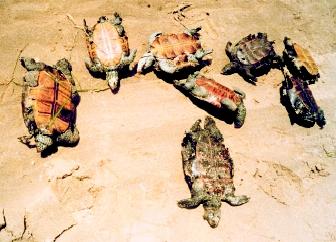Fish and Wildlife Issues
Fish and wildlife depend on water just as humans do. However, humans often reduce the access of fish and wildlife to sufficient quantities of usable water. The water management practices most directly affecting fresh-water fish and wildlife are water storage, water diversion, and channel control. Land-use changes such as deforestation, road-building, and urban development, with their associated pollution problems, are a few examples of various human activities that clearly affect wildlife habitats . However, these topics are addressed elsewhere in this encyclopedia, as are issues surrounding marine environments (e.g., ocean pollution, overfishing, and climate change).
Water Management Practices
Storage.
Water is stored in reservoirs (large impoundments) for flood control, water supply, hydropower production, and recreation. Reservoir storage affects water quality because a hydrologic system developed under flowing-water conditions (i.e., a stream or river) has been changed to a still-water

Two examples of storage effects on the water in a lake-like reservoir are thermal stratification (layering) and increased sedimentation (deposition of sediment materials). A stratified reservoir will be colder at the bottom than at the surface, and its dissolved oxygen supply will be from surface diffusion from the atmosphere and from photosynthesis , rather than from the turbulence of flowing water in a stream. In an especially deep reservoir, the oxygen will not be available at depth because stratification will restrict mixing of overlying oxygenated waters with the deeper, oxygen-deficient waters. Sedimentation in the reservoir will occur because the formerly flowing water loses much of its capacity to carry silt and clay when its velocity is greatly slowed; consequently, solid materials will more easily settle to the reservoir bottom.
The water downstream of the reservoir will flow only as the demands of the reservoir allow. A reservoir with a demand for a long-term, stable water level to meet recreational uses may release water only rarely, depending on the upstream supply. A reservoir managed for hydropower, on the other hand, will release water at frequent intervals and in varying amounts to meet power-supply needs.
The water downstream of the reservoir is affected by upstream storage. If water released from storage is taken from the reservoir's deeper, cooler levels, the water temperature downstream will be low; if reservoir water is taken from close to the Sun-warmed surface, the downstream water temperature may be high, especially in summer. Regardless of the source in the reservoir, the water released will be lower in suspended sand, silt, and clay particles because much will have been removed by sedimentation.
Diversion.
Water sometimes is diverted from flowing streams for irrigation and for municipal and industrial purposes. Diversion reduces the amount of water available in the stream channel, and changes the physical and chemical characteristics of the water diverted, so that when (and if) it returns to the channel, it will significantly affect the quality of water in the channel.
Evapotranspiration from the crops and soil in agricultural fields reduces the amount of available water by about two-thirds, and increases the concentration of salts in the water, because the salts do not evaporate. Subsurface return flows after irrigation can carry high salt concentrations back to streams.
Water diverted for municipal and industrial purposes is used primarily for cooling and cleaning. Return flow to streams in sewers and drainage ditches carries the wastes from cleaning and the heat from cooling back to streams.
Channel Control.
In an effort to control flooding, a winding stream channel may be cleaned of large debris (known as snagging and clearing), dredged (to deepen the channel), and even straightened or channelized . Sometimes, for road construction or other land uses, a channel may be "moved" by building a new channel. The effect of these kinds of channel-control measures is to increase the rate of flow in the stream, and to reduce the amount of material in the channel.
Although these measures have human benefits, they can damage wildlife habitat by removing riparian (streamside) vegetation, disturbing bottom sediments (which sometimes release pollutants "stored" within them), and causing increased erosion and sedimentation downstream that can smother valuable substrate habitats.
Impacts and Assessments
The water management practices described above—storage, diversion, and channel control—can affect resident fish and wildlife communities, as well as migratory animals making use of an area for resting and breeding. The impacts of such management practices fall into two broad categories: effects on physical habitat—areas in which plants and animals live; and effects on the water itself—chemical characteristics, temperature, and velocity.
Riparian Vegetation and Substrate Conditions.
Riparian (streamside) vegetation and stream-bottom character are significant habitat factors for organisms in or highly dependent on the water. Riparian vegetation helps shade and cool the stream, reduce the entry of pollutants and debris, and provide habitat for streamside plants and animals. Logs, branches, rocks, and debris in the stream itself similarly provide refuge for many species. Bottom substrates provide growth conditions necessary to the health and development of communities of bottom-dwelling invertebrates that largely constitute the base of the aquatic food chain . For this reason, channel scouring, channel reconstruction, and similar management practices can have damaging effects on the health of aquatic populations.
Water Quantity and Quality.
Water supply and velocity conditions are as important as substrates in the health and development of aquatic communities. Where a community has adapted to a particular flow regime, significant changes in the regime will challenge its health and well-being. The change from a flowing-water regime to a still-water regime as the result of

A less obvious but perhaps more critical result of water management is the challenge to the health of a stream community in a section of stream wherein water quantity has been reduced because of upstream diversions for municipal, industrial, hydropower, or agricultural use. Aquatic communities downstream of a hydropower plant face frequent changes in water supply and velocity as power demands change the amount of flow through the plant. Often, chemical and temperature balances changed by flow management from reservoirs, or by agricultural return flows, can significantly change aquatic communities.
Assessing Aquatic Health.
The health and well-being of an aquatic population is reflected in a change in the kinds, number, and variety of species present. Managers concerned with maintaining or enhancing the health of the community often look for critical indicator organisms or community assemblages to help them in evaluating management practices.
An indicator species is a plant or animal used as a measure of the environmental conditions in a particular area, such as the proverbial canary in a coal mine. The presence of certain aquatic insects—such as caddis flies—is sometimes taken as an indicator of good health in a body of water.
Often, an assemblage of organisms is a better indicator of environmental health than the presence or absence of a single organism. The combination of the number and variety of several different species frequently is used as a "biotic index" of the community health in a reach of stream or other body of water.
SEE ALSO Amphibian Population Declines ; Biodiversity ; Bivalves ; Crustaceans ; Desert Hydrology ; Ecology, Fresh-Water ; Endangered Species Act ; Fish ; Fish and Wildlife Service, U.S. ; Fisheries, Fresh-Water ; Forest Hydrology ; Instream Water Issues ; Lake Health, Assessing ; Lake Management Issues ; Lakes: Biological Processes ; Lakes: Physical Processes ; Land Use and Water Quality ; Ocean Health, Assessing ; Pollution by Invasive Species ; Pollution Sources: Point and Nonpoint ; Reptiles ; Runoff, Factors Affecting ; Stream Health, Assessing ; Uses of Water ; Watershed, Restoration of a ; Watershed, Water Quality in a .
N. Earl Spangenberg
Bibliography
National Research Council Committee on Restoration of Aquatic Ecosystems—Science Technology, and Public Policy. Restoration of Aquatic Ecosystems. Washington, D.C.: National Academy Press, 1992.
Simon, Thomas P., ed. Biological Response Signatures: Indicator Patterns Using Aquatic Communities. Boca Raton, FL: CRC Press, 2002.
Smith, Robert L. Ecology and Field Biology. New York: Harper & Row, 1980.
Wetzel, Robert G. Limnology, 2nd ed. Philadelphia, PA: W. B. Saunders Co., 1983.
Comment about this article, ask questions, or add new information about this topic: